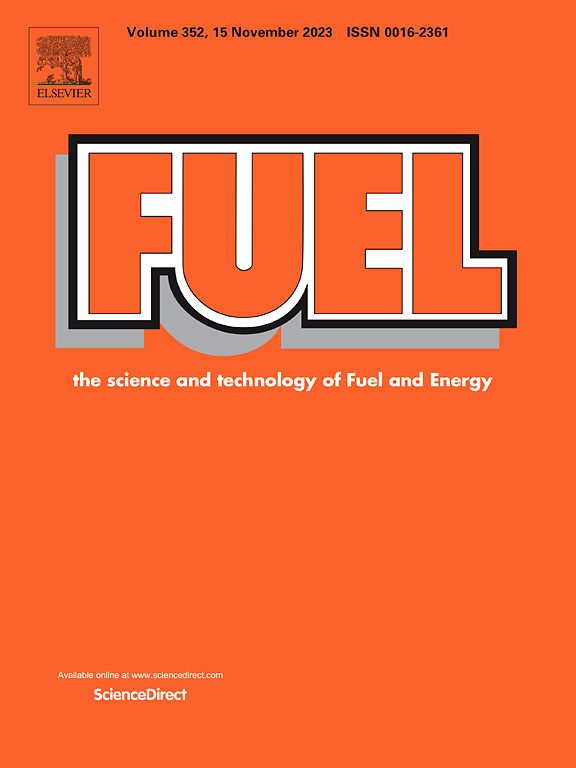Stabilization of lean premixed turbulent flames behind a backward-facing step: Numerical analysis of shear stretch-vorticity effects
IF 7.5
1区 工程技术
Q2 ENERGY & FUELS
引用次数: 0
Abstract
This study explored the stabilization of lean premixed turbulent flames in a backward-facing step combustor, using Large Eddy Simulation with the Artificially Thickened Flame model in OpenFOAM. Parametric variations in initial temperature (T0 = 300–500 K), Reynolds number (Re = 5000–7000), and equivalence ratio (Φ0 = 0.575–0.650) elucidated the interplay of hydrodynamic and chemical factors governing flame anchoring. The results demonstrate that the flame leading edge shifts upstream with increasing T0-Re and Φ0, a trend corroborated by experimental CH* chemiluminescence data. The x-distance of the flame leading edge was driven by a velocity balance mechanism wherein the turbulent flame speed, scaling with the square of the laminar burning velocity, aligned with the local flow velocity. Departing from the effect of turbulence intensity, this analysis for the flame leading edge points identified negative vorticity, induced by the shear-layer velocity gradient, as a key enhancer in the turbulent flame speed through shear stretch. The averaged characteristic rotating velocity exhibited a near-perfect linear relationship with the square of the laminar burning velocity, underscoring its pivotal role in flame stabilization. Morphological analyses indicated increased flame wrinkling under elevated T0-Re and reduced Φ0. Acoustically, the overall sound pressure level aligned closely with experimental trends, indicating that the noise generation is attributed to vortex shedding associated with the turbulence intensity at the flame leading edge points. Validated against a two-dimensional domain using the Paczko chemical mechanism, these findings highlight the dominance of shear-induced vorticity over turbulence intensity in flame stabilization, offering fresh insights into flame-turbulence interactions.
后台阶后稀薄预混湍流火焰的稳定:剪切拉伸涡度效应的数值分析
本研究利用OpenFOAM中人工增厚火焰模型的大涡模拟,探讨了后台阶燃烧室中稀预混湍流火焰的稳定化问题。初始温度(T0 = 300-500 K)、雷诺数(Re = 5000-7000)和等效比(Φ0 = 0.575-0.650)的参数变化阐明了控制火焰锚定的水动力和化学因素的相互作用。结果表明,随着T0-Re和Φ0的增加,火焰前缘向上游移动,这一趋势得到了实验CH*化学发光数据的证实。火焰前缘的x距离由速度平衡机制驱动,其中湍流火焰速度随层流燃烧速度的平方成比例,与局部流动速度对齐。从湍流强度的影响出发,通过对火焰前缘点的分析,发现剪切层速度梯度引起的负涡度是湍流火焰剪切拉伸速度的关键增强因素。平均特征转速与层流燃烧速度的平方成近似完美的线性关系,表明其在火焰稳定中的关键作用。形态学分析表明,T0-Re升高时火焰起皱增加,Φ0减少。声学上,总体声压级与实验趋势一致,表明噪声的产生是由于火焰前缘湍流强度引起的涡脱落。利用Paczko化学机制在二维域中进行验证,这些发现强调了剪切诱导涡度在火焰稳定中的主导地位,为火焰-湍流相互作用提供了新的见解。
本文章由计算机程序翻译,如有差异,请以英文原文为准。
求助全文
约1分钟内获得全文
求助全文
来源期刊

Fuel
工程技术-工程:化工
CiteScore
12.80
自引率
20.30%
发文量
3506
审稿时长
64 days
期刊介绍:
The exploration of energy sources remains a critical matter of study. For the past nine decades, fuel has consistently held the forefront in primary research efforts within the field of energy science. This area of investigation encompasses a wide range of subjects, with a particular emphasis on emerging concerns like environmental factors and pollution.
 求助内容:
求助内容: 应助结果提醒方式:
应助结果提醒方式:


